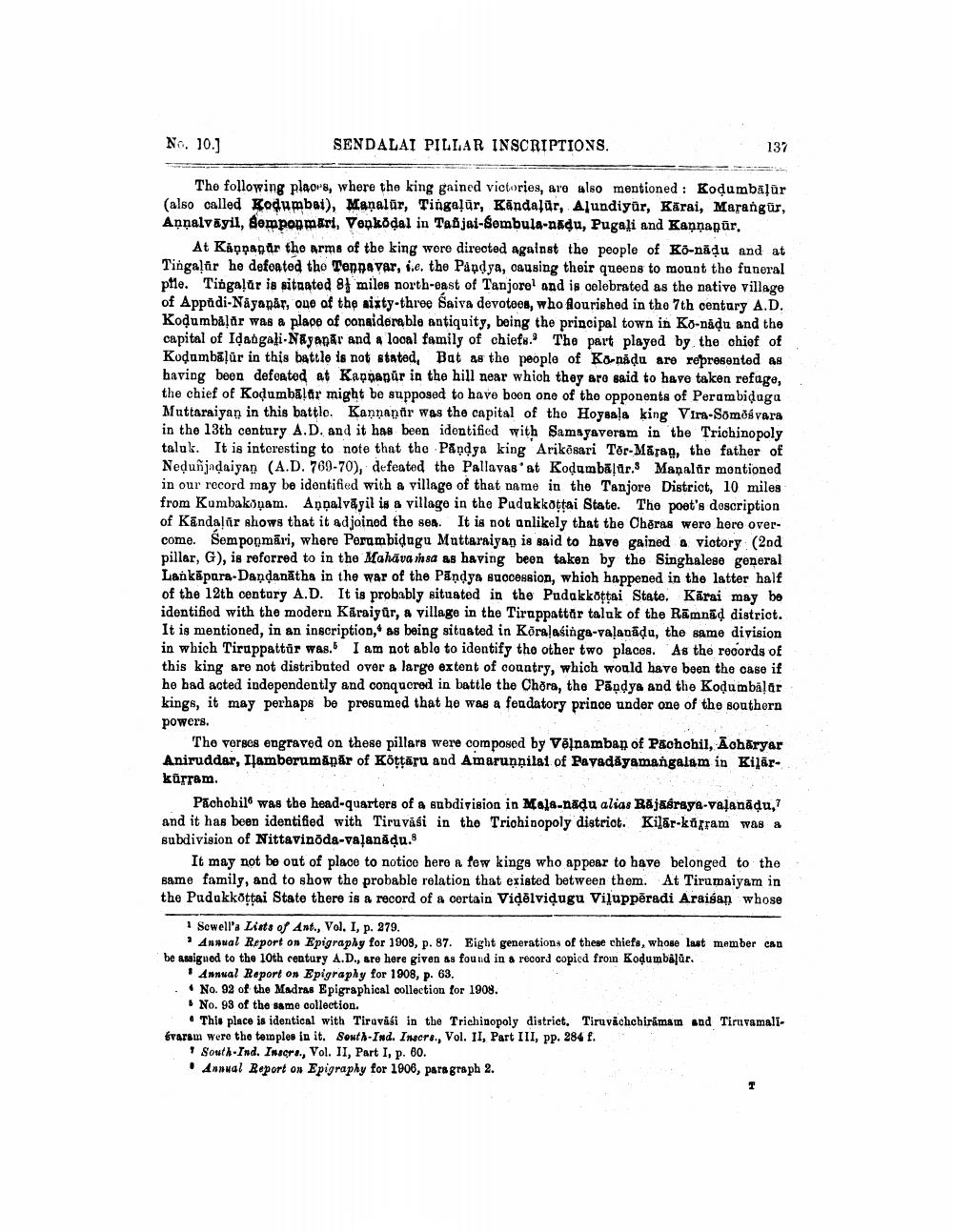________________
No. 10.)
SENDALAI PILLAR INSCRIPTIONS.
137
The following places, where the king gained victories, are also mentioned: Kodumbāļūr (also called Kodumbat), Manalür, Tingaļūr, Kāndalur, Alundiyür, Kārai, Marangur, Annalvāyil, Sempopmart, Vonkodal in Tafjai-Sombula-nadu, Pugali and Kannapūr.
At Käppapar the arms of the king wore directed against the people of Ko-nidu and at Tingalar he defeated the Tenpavar, ie, the Pandya, causing their queens to mount the funeral pfle. Tingaļár is situated 8f miles north-east of Tanjorel and is celebrated as the native village of Appüdi-Nayapår, one of the sixty-three Saiva devotoos, who flourished in the 7th century A.D. Kodumbasar was a place of considerable antiquity, being the principal town in Ko-nādu and the capital of Idangali-Nayanar and a local family of chiefs. The part played by the chief of Kodambīļür in this battle is not stated, Bat as the people of Ko-nádu aro represented as having been defeated at Kannapür in the hill near which they are said to have taken refuge, the chief of Kodumbalar might be supposed to have boon one of the opponents of Perambiduga Muttaraiyan in this battle. Kannanor was the capital of the Hoysa!a king Vira-Somosvara in the 13th contury A.D. and it has been identified with Samayaveram in the Trichinopoly taluk. It is interesting to note that the Pandya king Arikosari Tér-Māraq, the father of Neduñadaiyan (A.D. 769-70), defeated the Pallavas at Kodambīļür. Manalor montioned in our record may be identified with a village of that name in the Tanjore District, 10 miles from Kumbakonam. Appalvāyil is a village in the Pudukkottai State. The poet's description of Kāndalar shows that it adjoined the sea. It is not unlikely that the Cheras were here overcome. Semponmāri, where Perambidugu Muttaraiyan is said to have gained a victory (2nd pillar, G), is reforred to in the Mahāva sa as having been taken by the Singhalese general Lankäpara-Dandanātha in the war of the Pandys suocession, which happened in the latter half of the 12th century A.D. It is probably situated in the Pudakkottai State. Kārai may be identified with the modern Kāraiyür, a village in the Tirappattar taluk of the Rāmnad district. It is mentioned, in an inscription, as being situated in Kõralasinga-valanādu, the same division in which Tiruppattár was. I am not able to identify the other two places. As the records of this king are not distributed over a large extent of country, which would have been the case if he had acted independently and conquered in battle the Chora, the Pandya and the Kodumbalar kings, it may perhaps be presumed that he was a feudatory prince under one of the southern powers.
The verses engraved on these pillars were composed by Vēlnamban of Pachohil, Acharyar Aniruddar, Ilamberumanar of Köttáru and Amarunnilat of Pavadāyamangalam in Kijār. kurram.
Prohchil was the head-quarters of a subdivision in Moja-nadu alias Rajasraya-valanādu, and it has been identified with Tiruvasi in the Trichinopoly district. Kilár-korram was a subdivision of Nittavinoda-valanādu.s
It may not be out of place to notice here a few kings who appear to have belonged to the same family, and to show the probable relation that existed between them. At Tirumaiyam in the Pudukkottai State there is a record of a certain Vidēlvidugu Viluppēradi Araisan whose
Sewellia Lists of Ant., Vol. I, p. 279.
Annual Report on Epigraphy for 1908, p. 87. Eight generations of these chiefs, whose last member can be assigued to the 10th century A.D., are here given as found in a record copied from Kodumbaļür.
I Anwal Report on Epigraphy for 1908, p. 63.
No. 92 of the Madras Epigraphical collection for 1908. No. 93 of the same collection.
This place is identical with Tiravasi in the Trichinopoly district. Tiruvachchirimam and Tiruvamalibvaram were the temples in it. South-Ind. Inscrs., Vol. II, Part III, pp. 284 f.
South-Ind. Inscra., Vol. II, Part I, p. 60. • Annual Report on Epigraphy for 1906, paragraph 2.




